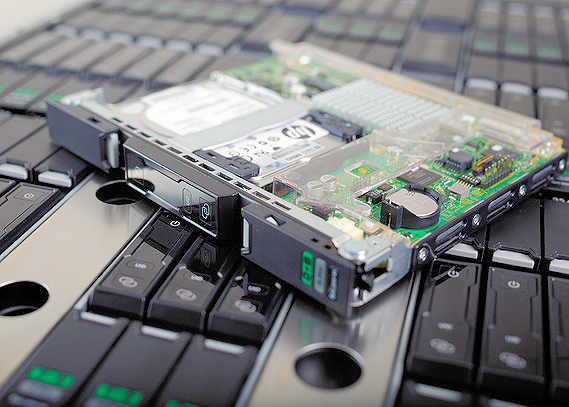Server Update April 2013: Positioning the HP Moonshot 1500
by Johan De Gelas on April 11, 2013 8:11 AM EST- Posted in
- Enterprise CPUs
- Arm
- Xeon
- Enterprise
- Calxeda
- S1200
The Moonshot Server Cartridge
As always, HP's server chassis is a well designed, excellent documented chassis with tons of options. However, the server node, or cartridge as HP likes to call it, is the part that will run the software services and the key factor when trying to estimate the performance per watt ratio that this server is capable off.
The server cartridges look like very small blade servers. Inside we find the Atom S1260 at 2GHz, one SO-DIMM slot with 8GB of 1333 MHz of ECC protected DDR-3, a Broadcom 5720 Dual port 1 Gb Ethernet controller and a Marvell 9125 SATA controller.

HP also incorporates a local 500GB SATA drive and later on it will be possible to buy a 200GB SSD or 1 TB SATA disk.
The Atom S1260 "Centeron"
Ryan already broke the news on the Atom S1260, but it is good to recap. The Atom launched in 2008 and the CPU architecture was called Bonnel. Bonnel was a dual issue, in order design with a rather long pipeline (16 stage).
Since then, the core architecture has had one minor update, codenamed "Saltwell". Saltwell came with an improved branch predictor and a post-fetch instruction buffer to make sure that the same instructions are not fetched twice. Those were about two of the very few IPC improving features that Saltwell added. Saltwell also got turbo boost and finer grained DVFS (Dynamic Voltage and Frequency scaling). All other improvements were almost strictly power related: the L2-cache got a separate voltage rail, deep sleep state C6 was added.
In the some models, the L2-cache doubled to 1 MB. The end result was that we found Saltwell cores to be about 8% faster than Bonnel based cores, clock for clock. Using a similar amount of power, the 32 nm Saltwell core at 1.86GHz (N2800) was about 20% faster than the older 45 nm 1.66GHz Atom N450 with Bonnel architecture.
The Atom S1260 uses the same "Saltwell" core as all current Atoms. Intel added ECC support, support for twice as much memory (8 vs 4GB), the virtualization technology VT-x, and 4 extra PCIe lanes (8 in total). Those features were necessary to make it a worthy member of the Xeon family.
HP chose the fastest member of the S1200 family, the S1260. This Atom operates at 2GHz and comes with a 8.5 W TDP. It is interesting to note that despite the focus on power efficiency, HP did not favor the S1240 at 1.6GHz with a 6.1 W TDP.










26 Comments
View All Comments
pixelstuff - Thursday, April 11, 2013 - link
The acronyms were quite prolific in this article.WeaselITB - Thursday, April 11, 2013 - link
IDK, TLAs R AOK w/me.mayankleoboy1 - Thursday, April 11, 2013 - link
AFAIk, LZMA uses only two threads...LZMA2 can use as many as required. Can you do another benchmark, this time with LZMA2 algo, and set the number of threads to something big.
mayankleoboy1 - Thursday, April 11, 2013 - link
Nevermind, i thought you were testing on the complete thing, not only one node.JohanAnandtech - Thursday, April 11, 2013 - link
The benchmark actually spawns 4 threads if you instruct it to do that.mayankleoboy1 - Thursday, April 11, 2013 - link
Those 4 threads would be 4 processes, right ? Or a single process with 4 threads ?Kevin G - Thursday, April 11, 2013 - link
Any news of Intel's ISCCC coming to market? Even if performance is the same, it further integrates the various nodes further for greater density and the possibility of lower performance.Gigaplex - Thursday, April 11, 2013 - link
I wonder how AMDs Bobcat would compare in this scenario.Spunjji - Friday, April 12, 2013 - link
Probably average, not great at anything though as its PPW is probably lower than ARM in this scenario. That's mostly due to outdated process tech, though, so Jaguar might well be a nice competitor; even more so if people can figure out novel ways to use the GPU.fteoath64 - Wednesday, April 17, 2013 - link
The Atom is between a rock-and-a-hard-place. It is only good for consumer NAS devices and nothing really else. The Bobcat cores are worse in power consumption while 25% SLOWER than the Atom , so it is pretty useless, although its gpu is rather respectable at 80 cores. The low power Xeon Haswell is rather nice and should be developed (or sliced and diced) into the "New" Atom2 architecture, saving Intel the dearth of the Atom brand that has long since been dead and beaten over and over. There is no shame for Intel on this "dead horse". they kept beating it for all to see!.